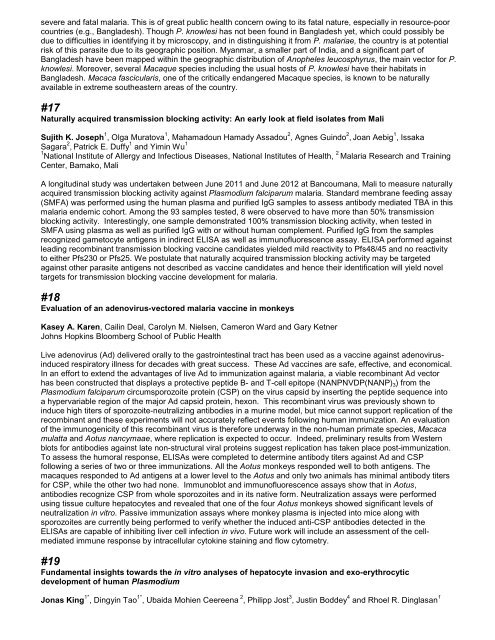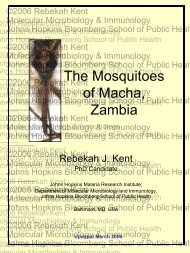Conference Program - Johns Hopkins Malaria Research Institute ...
Conference Program - Johns Hopkins Malaria Research Institute ...
Conference Program - Johns Hopkins Malaria Research Institute ...
You also want an ePaper? Increase the reach of your titles
YUMPU automatically turns print PDFs into web optimized ePapers that Google loves.
severe and fatal malaria. This is of great public health concern owing to its fatal nature, especially in resource-poor<br />
countries (e.g., Bangladesh). Though P. knowlesi has not been found in Bangladesh yet, which could possibly be<br />
due to difficulties in identifying it by microscopy, and in distinguishing it from P. malariae, the country is at potential<br />
risk of this parasite due to its geographic position. Myanmar, a smaller part of India, and a significant part of<br />
Bangladesh have been mapped within the geographic distribution of Anopheles leucosphyrus, the main vector for P.<br />
knowlesi. Moreover, several Macaque species including the usual hosts of P. knowlesi have their habitats in<br />
Bangladesh. Macaca fascicularis, one of the critically endangered Macaque species, is known to be naturally<br />
available in extreme southeastern areas of the country.<br />
#17<br />
Naturally acquired transmission blocking activity: An early look at field isolates from Mali<br />
Sujith K. Joseph 1 , Olga Muratova 1 , Mahamadoun Hamady Assadou 2 , Agnes Guindo 2 , Joan Aebig 1 , Issaka<br />
Sagara 2 , Patrick E. Duffy 1 and Yimin Wu 1<br />
1 2<br />
National <strong>Institute</strong> of Allergy and Infectious Diseases, National <strong>Institute</strong>s of Health, <strong>Malaria</strong> <strong>Research</strong> and Training<br />
Center, Bamako, Mali<br />
A longitudinal study was undertaken between June 2011 and June 2012 at Bancoumana, Mali to measure naturally<br />
acquired transmission blocking activity against Plasmodium falciparum malaria. Standard membrane feeding assay<br />
(SMFA) was performed using the human plasma and purified IgG samples to assess antibody mediated TBA in this<br />
malaria endemic cohort. Among the 93 samples tested, 8 were observed to have more than 50% transmission<br />
blocking activity. Interestingly, one sample demonstrated 100% transmission blocking activity, when tested in<br />
SMFA using plasma as well as purified IgG with or without human complement. Purified IgG from the samples<br />
recognized gametocyte antigens in indirect ELISA as well as immunofluorescence assay. ELISA performed against<br />
leading recombinant transmission blocking vaccine candidates yielded mild reactivity to Pfs48/45 and no reactivity<br />
to either Pfs230 or Pfs25. We postulate that naturally acquired transmission blocking activity may be targeted<br />
against other parasite antigens not described as vaccine candidates and hence their identification will yield novel<br />
targets for transmission blocking vaccine development for malaria.<br />
#18<br />
Evaluation of an adenovirus-vectored malaria vaccine in monkeys<br />
Kasey A. Karen, Cailin Deal, Carolyn M. Nielsen, Cameron Ward and Gary Ketner<br />
<strong>Johns</strong> <strong>Hopkins</strong> Bloomberg School of Public Health<br />
Live adenovirus (Ad) delivered orally to the gastrointestinal tract has been used as a vaccine against adenovirusinduced<br />
respiratory illness for decades with great success. These Ad vaccines are safe, effective, and economical.<br />
In an effort to extend the advantages of live Ad to immunization against malaria, a viable recombinant Ad vector<br />
has been constructed that displays a protective peptide B- and T-cell epitope (NANPNVDP(NANP)3) from the<br />
Plasmodium falciparum circumsporozoite protein (CSP) on the virus capsid by inserting the peptide sequence into<br />
a hypervariable region of the major Ad capsid protein, hexon. This recombinant virus was previously shown to<br />
induce high titers of sporozoite-neutralizing antibodies in a murine model, but mice cannot support replication of the<br />
recombinant and these experiments will not accurately reflect events following human immunization. An evaluation<br />
of the immunogenicity of this recombinant virus is therefore underway in the non-human primate species, Macaca<br />
mulatta and Aotus nancymaae, where replication is expected to occur. Indeed, preliminary results from Western<br />
blots for antibodies against late non-structural viral proteins suggest replication has taken place post-immunization.<br />
To assess the humoral response, ELISAs were completed to determine antibody titers against Ad and CSP<br />
following a series of two or three immunizations. All the Aotus monkeys responded well to both antigens. The<br />
macaques responded to Ad antigens at a lower level to the Aotus and only two animals has minimal antibody titers<br />
for CSP, while the other two had none. Immunoblot and immunofluorescence assays show that in Aotus,<br />
antibodies recognize CSP from whole sporozoites and in its native form. Neutralization assays were performed<br />
using tissue culture hepatocytes and revealed that one of the four Aotus monkeys showed significant levels of<br />
neutralization in vitro. Passive immunization assays where monkey plasma is injected into mice along with<br />
sporozoites are currently being performed to verify whether the induced anti-CSP antibodies detected in the<br />
ELISAs are capable of inhibiting liver cell infection in vivo. Future work will include an assessment of the cellmediated<br />
immune response by intracellular cytokine staining and flow cytometry.<br />
#19<br />
Fundamental insights towards the in vitro analyses of hepatocyte invasion and exo-erythrocytic<br />
development of human Plasmodium<br />
Jonas King 1* , Dingyin Tao 1* , Ubaida Mohien Ceereena 2 , Philipp Jost 3 , Justin Boddey 4 and Rhoel R. Dinglasan 1



